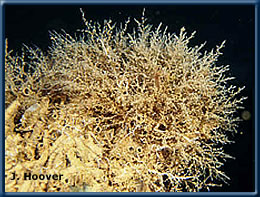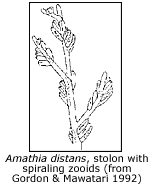

Schizoporella errata

Amathia distans

Bugula neritina
Amathia distans
 Bushy
bryozoan
Bushy
bryozoan
Phylum Ectoprocta
Class Gymnolaemata
Order Ctenostomata
Family Vesiculariidae
Description
This bryozoan forms soft, bushy growths, 5-20 cm in diameter. The flexible
stolons (branches) are usually coated with silt and diatoms which gives
the colonies a muddy brown color. The colonies consist of short, erect
zooids (individuals) arranged biserially in a spiral around each stolon
segment.
Habitat
Primarily as fouling in shallow water on hard substrates (pilings, hulls,
coral rubble, etc.) in harbors and embayments. Occasionally found on the
reef in more protected areas.
 Distribution
Distribution
Hawaiian Islands
Throughout main Hawaiian Islands and also Midway Atoll.
Native Range
Caribbean
Present Distribution
North Carolina to Brazil, Mediterranean and Red Sea, Puget Sound to the
Gulf of California, Australia, New Zealand, Java, Japan, and Hawaiian
Islands.
Mechanism of Introduction
Unintentional, as fouling on ships' hull or as larvae in ballast water.
Impact
Fouling organism. Ecological impact unstudied, but presumed minimal.
Ecology
Feeding
The bryozoan is a suspension feeder. It has a retractable U-shaped crown
of tentacles (lophophore) which bear cilia that create a current, bringing
food particles toward the animal. Particles are then guided into the mouth
by action of the tentacles and cilia.
Reproduction
Each bryozoan colony begins from a single, sexually produced, primary
zooid. This zooid undergoes asexual budding to produce a group of daughter
cells, which themselves form buds, and so on. Most bryozoans are hermaphroditic,
each zooid capable of producing sperm and eggs. Sperm is released into
the coelom and the fertilized eggs are retained and brooded for a time
before being released.
Remarks
First reported from Kaneohe Bay by Edmondson and Ingram (1939, based on
1935 collections), this bushy broyozoan is now a well established fouling
species, reported throughout the main Islands. It was also one of the
few alien marine invertebrates found at Midway Atoll when surveys were
conducted there in 1998 (DeFelice et al. 1998).
References
Edmondson, C.H. and W.M. Ingram. 1939. Fouling organisms in Hawaii. Occ.
Pap. B.P. Bishop Museum. 14(14): 251-300.
DeFelice, R.C., S.L. Coles, D. Muir, and L.G. Eldredge. 1998. Investigation
of the marine communities of Midway Harbor and adjacent lagoon, Midway
Atoll, Northwestern Hawaiian Islands. Hawaii Biol. Survey, Bishop Museum
(HBS Contrib. No. 1998-014).
© 2002 Hawaii Biological Survey, Bishop Museum
contact